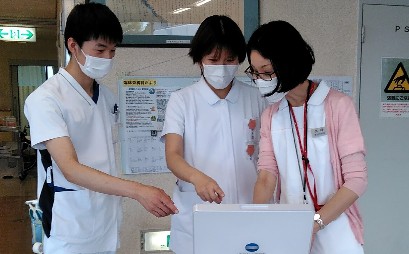JIU Josai International University

Associate Professor Kitada conducts a survey at a public long-life hospital to eliminate problems that occur during intravenous drips
teaching activity
2023.07.05

Associate Professor Motoko Kitada (right) and nurses at the Public Long Life Hospital reviewing survey data
Although intravenous drips are routinely used as part of medical treatment, they often cause problems such as redness and pain at the site of needle insertion. Associate Professor Motoko Kitada of Faculty of Nursing is working on a survey Research to reduce the pain caused by such intravenous drips. With the cooperation of Chosei Public Hospital (Mobara City, Chiba prefecture), we will analyze and investigate actual cases in the field over the next year to Research make it possible to administer drugs and nutrients more safely.
In general drip infusion (intravenous drip), a needle (indwelling needle) is inserted into the skin and vein, and then a thin, soft tube (peripheral venous catheter) is left in the blood vessel and the needle is removed. If the treatment is completed in a short period of time, a needle (winged needle) may be inserted into the blood vessel without using a catheter. It will remain in detention. As a result, symptoms such as redness, pain, swelling of the skin at the insertion site such as the arm, and problems such as the inability of medicines and nutrients to enter the blood vessels well occur in all cases. It is said to be as high as 30-50%. In these cases, it is also necessary to remove the catheter and replace it with a new one. This situation is not only painful for the patient, but also leads to an increase in workload and costs in the nursing field, so improvements are required.
In this study, the Research group led by Associate Professor Kitada will obtain consent from patients undergoing treatment at the Public Chosei Hospital, and will use ultrasound to visualize the state of catheters during infusions, as well as changes in blood vessels and surrounding tissues, to collect data on around 100 cases. The goal is to analyze the results and derive the conditions for safe and smooth infusions.
At the start of the survey, Associate Professor Kitada said, "I will do my best to reduce the number of patients who have to repeatedly pull out and insert needles and have a painful experience with intravenous drips."